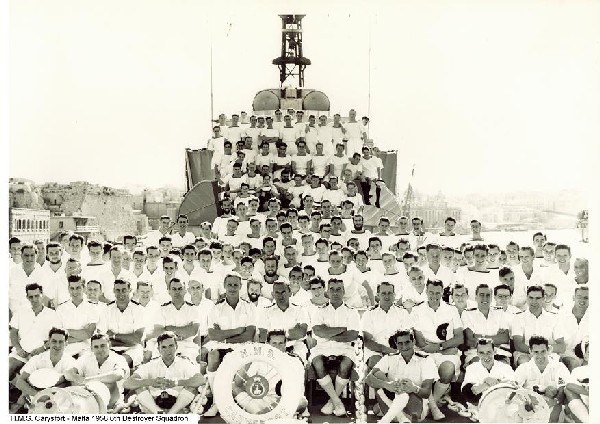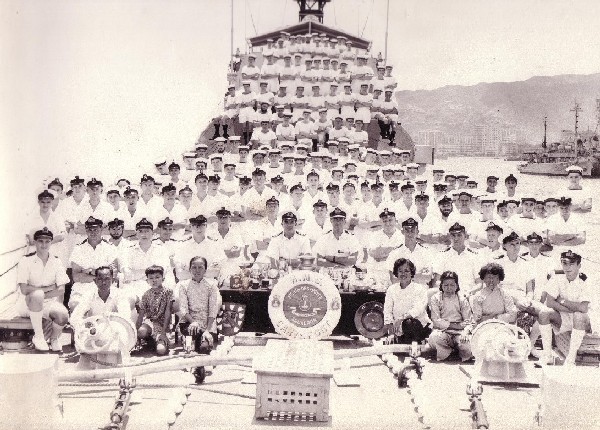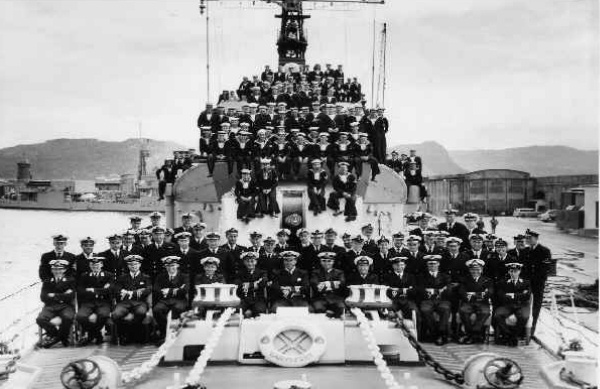![]()

![]()
![]()
Introduction
My New Year's resolution for 2004, which by co-incidence was the 60th anniversary of the launch of HMS Carysfort, was to create a website dedicated to her, my first ship in the Royal Navy, for her final commission 1966-69. The life experiences gained in this happy, hard working and well led ship were to stand me in good stead for the next 30 plus years of my Naval career. They say that it is not the ship, but the men who serve in her, who create a reputation that becomes known throughout the RN of a happy ship so Carysfort must have been exceptionally lucky to have been blest with such a good Ship's Company, Officers and Captains over her seven commissions. Only two of of her seven commissions did not spend any time in the Far East (FES).
Apart from HMS Cavalier which is preserved in Chatham and gained the title of "the fastest ship in the fleet" after narrowly beating the ERA Apprentices training ship, HMS Rapid in a race over 64 miles on 6th July 1971 off the Firth of Forth, the other CA's are indeed grey ghosts of the sea who seem to have disappeared into obscurity. Incidentally, HMS Cavalier is the last remaining of the 96 emergency destroyers built during WWII.
![]() Just
recently I've discovered that HMS Warwick which was sunk in the SW
approaches by the German submarine U-413 on 20th February 1944 had the
pennant number D25. The Admiralty didn't waste much time in
transferring this pennant number to Carysfort.
Just
recently I've discovered that HMS Warwick which was sunk in the SW
approaches by the German submarine U-413 on 20th February 1944 had the
pennant number D25. The Admiralty didn't waste much time in
transferring this pennant number to Carysfort.
I hope this website rekindles some interest in Carysfort, particularly those of you who have served onboard. Who knows - it may even tempt you to have a search in the attic and dust off your old photo albums! You can share your photos with us here. Several ex Carysfort's have been in touch already via email and have provided most of the information on the site - many thanks. There is also a page to post memories of your time onboard.
Finally - a word of warning! This is my first attempt at building a website so please bear this in mind. If I was to sum up my computer knowledge in one word it would be "destitute"
Happy browsing,
Jim Donaldson
March 2004
![]()
Hard to believe it is over 10 years since HMS Carysfort's website was set up. My sincere thanks to all who have contributed photos, sea stories, memories etc of this fine ship. There's too many to mention individually but you know who you are. However, I am sure there are more photos and sea stories to be had so please make a real effort to have them published on the website for all to share.
Jim Donaldson - May 2014
![]()
HMS Carysfort was a destroyer of the 'C' type "Caesar" Class authorised in the naval programme of 1941. Originally ordered as HMS Pique her name was changed to conform with the initials CA in common with her 7 sister ships. She is named after John Probin. a politician who was also a Lord of the Admiralty in 1750. In 1752 he was created a baron and chose for himself the name of Carysfort. His son, the Earl of Carysfort served in HMS Victory for two years and eventually became an Admiral. She was the fifth RN warship to carry the name Carysfort.
Britain's fortunes at sea were at a very low ebb in early 1942. It is no exaggeration to describe the situation as critical and the need for more convoy escorts as desperate. In this light the order for job number J6131 was given on 16th February 1942 and HMS Pique took her place on the books of Cammell Laird. Elsewhere on this day 7 tankers had been torpedoed and the previous day Singapore had surrendered. Britain was therefore deprived of her last remaining Far Eastern and East Indian base so convoy escorts were priceless assets. Cammell Laird had a host of other orders for equipment so steel was transferred to the yard of J Samuel White & Co East Cowes, Isle of Wight.
So she was built and engined by J Samuel White & Co. The keel was to be laid down on 4th May 1943 but was delayed until 12 May 1943 because of German bombing raids. She was launched on 25 July 1944 and completed on 20 February 1945. Her original pennant number was R25.
Eight destroyers of the CA Class were built, the other ships being named: Cavendish (D15), Cambrian (D85), Cassandra (D10), Cavalier (D73), Caprice (D01), Caesar (D07) and Carron D30). They were designed for the anti-aircraft and anti-submarine defence of Carrier Task Forces and convoys and were also fully capable of anti-shipping/bombardment action.
They were all propelled by conventional steam turbines and displaced 2053 tons on an overall length of 362 feet and a beam of 36 feet. With a top speed of around 34 knots they could make life pretty uncomfortable for all on board.
![]()
![]()
After work up at Scapa Flow she joined the 6th Destroyer Flotilla Home Fleet on what proved to be their last offensive operation in the War in Europe, a seaborne air attack on the German U-boat depot ships at Kilbotn, Norway, north west of Narvik, on 5th May 1945. The submarine Depot ship Black Watch was sunk. One U-boat, U711 was sunk at Harstadt and the Norwegian tanker Senja in a nearby berth was also destroyed.
Between 7th and 10th May Carysfort left with other ships on Operation Cleaver - the safe conduct of a British naval force through the Skagerrak- bringing assistance to the peoples of enemy-occupied countries. She assisted in operations against German merchant shipping until VE day. In the last week of May she went to Tromso, returning to Scapa on the 31st.
The 6th Destroyer Flotilla was allocated to the British Pacific Fleet and on 14th June Carysfort left Rosyth for Portsmouth to refit until August. She was thus still in home waters when the war with Japan ended on 15th August 1945 and the allocation of the 6th Flotilla was changed to the East Indies Station. She went to Portland on 17th September to shake down and left on the 28th for her station, arriving at Aden on 6th November and Colombo on 13th November.
She served on the East Indies Station until May 1946 when she returned home, arriving at Portsmouth on 28th May. She was reduced to the Reserve Fleet there.
![]()
![]()
To view memories posted this commission please
![]()
![]() to see a complete detailed
programme of the 1945/46 commission compiled by Harold Walker but kindly provided by John Hedges and
another handwritten one by Bill Elliott who was onboard for the same
commission.
to see a complete detailed
programme of the 1945/46 commission compiled by Harold Walker but kindly provided by John Hedges and
another handwritten one by Bill Elliott who was onboard for the same
commission.
![]()
1946-1954
![]()
![]()
1954-1956 at Yarrows, Scotstoun, Glasgow
![]()
![]()
To view memories posted by this commission please
![]()
![]()

Malta 1958
![]()
![]()

Hong Kong
To view memories posted by this commission please
![]()
![]()

Hong Kong
![]()
Long Refit  Gibraltar
Gibraltar
November 1962 - May 1964
![]()
![]()

Cawsand Bay
![]()
![]()
Simonstown Naval Base - South Africa - October 1968
![]()
